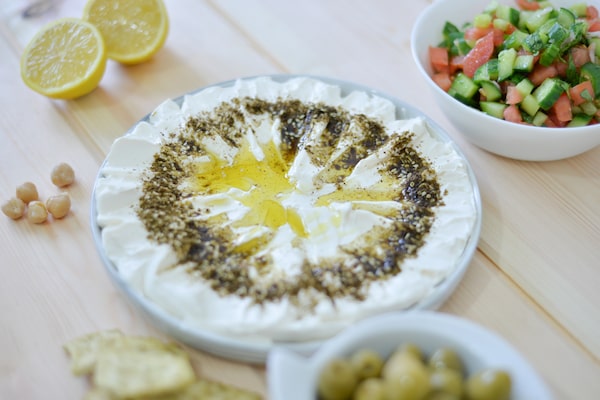
Labneh is a thickened yogurt with added salt.Yana Margulis Rubin/iStockPhoto / Getty Images
Middle Eastern cuisine is more than falafel and hummus. Due to the popularity of books by chefs such as Yotam Ottolenghi, who explore their countries’ foodways, this fresh, textured, vegetable-forward food comes alive with a simple Middle Eastern pantry. Here are some key ingredients to consider having on hand.
Labneh A thickened yogurt with added salt. You can buy it, but making your own provides superior results. Line a strainer with cheesecloth and set it over a bowl. Add 1 carton of full-fat yogurt plus 1 tsp Kosher salt. Let it drain for 6 to 24 hours in the refrigerator, depending on your preferred texture, discarding the liquid occasionally. The longer it drains, the thicker it becomes; after 24 hours it will be almost like cream cheese. The thickened yogurt is now labneh, which can be used for sauces and dips, or as a swirl, topped with herbs and spices, to garnish dishes.
Zaatar A spice blend, combining thyme, oregano, sumac (which has a tangy, lemony flavour), salt and sesame seeds. You can make your own but is easy to find nowadays and is always carried in Middle Eastern supermarkets. Use it for seasoning labneh, salads, pita and other dishes.
Cooking 101: Lucy Waverman decodes cooking techniques everyone can master
Baharat An Arab all-purpose spice mixture that contains cumin, coriander and other spices, but no real heat. Here is an easy one that I adapted from The Palomar Cookbook, a gorgeous modern Israeli cookbook with excellent recipes. In a spice grinder, grind 2 tbsp peppercorns, 4 tbsp toasted cumin seeds, 2 tbsp toasted coriander seeds, 1 tsp allspice berries and 1 tsp whole cloves until powdery. Add 2 tbsp sweet paprika (not smoked), 1 tsp ground cardamom and 1 tsp ground cinnamon. Mix well. Use it as a rub for grilled meats, sprinkled over chicken before baking or mixed with olive oil and massaged into lamb before roasting. There is no end of uses, so make lots.
Pomegranate molasses Essentially a reduction of pomegranate juice, this is a thickened, sticky liquid used extensively in Iranian cooking and elsewhere. You can make your own by slowly simmering 4 cups pomegranate juice with 1/3 cup sugar and 1 tsp lemon juice until syrupy, about 45 minutes to an hour.
Freekeh An ancient grain that is simply wheat picked while still green. After burning off the outer husk, the pliable, slightly chewy grain is left. It is a whole grain that provides a good source of protein and fibre. To cook, bring a large pot of water to boil and boil the grains until tender, but still a little chewy, about 15 minutes. Drain, cover and let sit for 10 minutes. Like bulgur, freekeh is used extensively as a side dish.
Tahini A paste made from sesame seeds, this is a major ingredient in Middle Eastern cooking. Hummus would be boring without it. The quality and taste differ depending on whether the seeds are hulled or unhulled, toasted or not. Grinding also affects the flavour, stone-ground being the ultimate. I like to make my own. Place 1 cup hulled white sesame seeds in a dry pan over medium heat and slowly brown. When they are pale gold, toss them in the food processor or heavy-duty blender with 3 tbsp olive oil. Process until creamy. If you want it thinner, add more oil. The paste should be nutty and smooth with a hint of sweetness. Store any extras in the refrigerator.
Other key ingredients include lemony sumac, spicy harissa, complex but not too spicy Aleppo pepper, and tiny tart barberries.
Need some advice about kitchen life and entertaining? Send your questions to lwaverman@globeandmail.com.